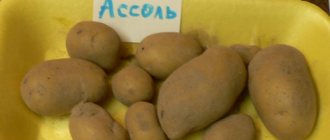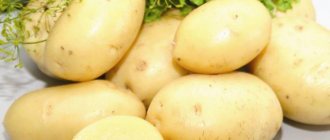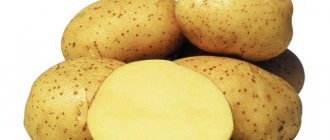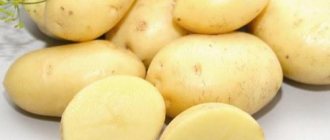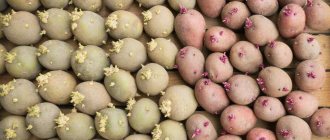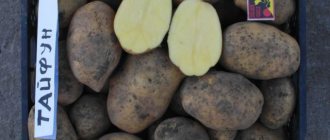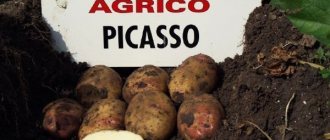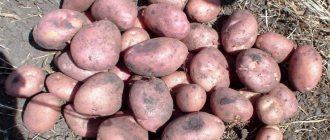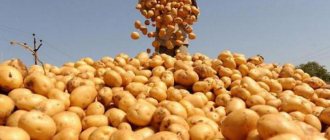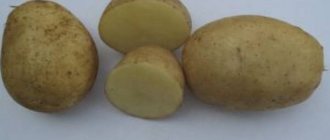Characteristics of the Lady Claire potato variety
The bush of the plant reaches a height of 50 cm, is medium compact, and erect. The main stems of potatoes are strong and dense, maintaining an upright position until harvest.
The leaf blades are medium-sized, wrinkled, dark green in color. According to photos, reviews and description of the variety, Lady Claire potatoes quickly shed flowers without producing berries.
The length of the period varies depending on the preparation of the seed material. When germinating Lady Claire potatoes for 30 days, flowering begins after 2.5-3 months; with regular planting of tubers, flowers appear after 25-35 days. The duration of the process is no more than a week.
According to the description, Lady Claire potatoes are moderately resistant to frost. For a short period of time, the plant can tolerate a drop in temperature to + 4 °C, but during spring frosts the seedlings are quickly damaged. When the weather returns to normal, potatoes continue to grow, but yields decrease slightly.
Important! June frosts are dangerous for the Lady Claire variety, when flowers form and tubers form.
Characteristic
The “Red Lady” variety is zoned for the Central Black Earth, Caucasus, Middle Volga, and Far Eastern regions. Productivity depends on growing conditions, fertilizers used, irrigation schedule, and ranges from 17 to 30 tons per hectare.
The variety reaches its maximum yield on the 55th day after germination. Each bush produces at least 14 large potatoes; the amount of non-marketable small potatoes is insignificant.
You can compare the yield indicators of Red Lady with other varieties in the table below:
| Variety name | Productivity |
| Elizabeth | 80-140 c/ha |
| Vega | 90-120 c/ha |
| Colombo | 80-130 c/ha |
| Lugovskoy | 80-165 c/ha |
| Irbitsky | 108-185 c/ha |
| Borovichok | 200-250 c/ha |
| Lapot | 400-500 c/ha |
| Sturdy | 78-105 c/ha |
| Crimean rose | 75-120 c/ha |
| Agatha | 70-140 c/ha |
The potato bush is strong, medium height, erect. The leaves are medium-sized, dark green, of intermediate type, with a slightly wavy edge. The corolla is simple, flower buds quickly fall off.
Read on our website everything about the use of fungicides, herbicides and insecticides, their benefits and harms, methods of application.
The “Red Lady” variety is resistant to major diseases: potato canker, golden nematode, scab, blackleg, viral diseases and fungal infections: Alternaria, Fusarium, Verticillium. Increased sensitivity to late blight (on tops) was noted. Tubers are little subject to mechanical stress, which makes harvesting easier.
Potatoes have excellent taste. It is suitable for boiling, baking, stewing, and making purees. When cutting and heat treatment, the tubers do not darken, the color of the finished dishes is pleasant, creamy yellow. The taste is rich, without unnecessary dryness or wateriness. The tubers contain an increased amount of protein and B vitamins. The shelf life is 92% and storage is not particularly difficult. However, you can study this issue in more detail and read all about winter storage, in boxes, peeled, in the refrigerator, about the timing.
Sources
- https://sveklon.ru/kartofel-red-ledi-opisanie
- https://web-selo.ru/sort-kartofelya-red-ledi-harakteristika-opisanie-urozhajnost-otzyvy-i-foto.html
- https://fb.ru/article/314661/kartofel-red-ledi-opisanie-sorta-foto-otzyivyi-ob-urojaynosti
- https://ogorod-bez-hlopot.ru/red-ledi-kartofel-opisanie-sorta.html
- https://rusfermer.net/ogorod/korneplody/kartofel/sorta/rannespelye/red-ledi.html
Taste qualities of potatoes
The root system lies at a depth of 20-30 cm. On one bush of the Lady Claire variety, from 10 to 14 medium-sized tubers are formed.
Potatoes are characterized by an attractive appearance; curved samples are almost never found. The weight of each tuber varies between 80-120 g.
The shape of the variety is oval, slightly elongated. The eyes are small, in small quantities, located on the surface, which simplifies the process of cleaning and washing the crop.
The skin of the potato is thin, light golden in color, and dense. Tubers do not crack in the ground. The pulp inside is white-yellow, creamy, dense, without excess wateriness (solids content 16-19%).
According to the description, photos and reviews, Lady Claire potatoes do not become soft when cooked, and after peeling they do not change color for a long time.
The variety has a high taste quality: the tubers are sweetish and oily, excellent for boiling, frying, and stewing. Potatoes make good chips and other food products, which allows them to be used on an industrial scale.
Important! The nutritional value of potatoes is 83 kcal due to their high starch content (12-16%), so they are not recommended for people on a diet.
Description of the hybrid
Lady Claire potatoes were bred by breeders from the Netherlands. The original name of the hybrid is Lady Claire. The variety is recommended for cultivation on an industrial scale and in private farms. Lady Claire is included in the State Register of Agricultural Crops; these potatoes are proposed to be grown in the Central and North Caucasus regions.
Attention! The Lady Claire variety is a high-yielding mid-early hybrid for table use. These potatoes can be grown both in open ground and in greenhouse conditions.
Full description of the Lady Claire potato variety:
- early ripening periods - the growing season is 65-70 days (the first root crops can be dug up 1.5 months after the bushes germinate);
- medium-sized bushes - up to 50 cm in height;
- shoots are erect, well leafy;
- stems are powerful, not prone to lodging;
- leaves are wrinkled, large, emerald green, with wavy edges;
- the corollas are compact, the flowers are white, no berries are formed in their place;
- the root system is powerful, under one bush, on average, 10-12 tubers are formed;
- There are very few small and deformed potatoes - Lady Claire has a very attractive and highly marketable appearance;
- the shape of the tubers is oval, leveled;
- potatoes weigh from 80 to 120 grams;
- Lady Claire's peel is light yellow, quite dense, but thin;
- the pulp is yellowish-white, also of high density;
- There are few eyes on the potatoes, they are small and shallow (the Lady Claire variety is suitable for machine washing and peeling);
- the taste characteristics of potatoes are high – 4 out of 5 points;
- Lady Claire tubers contain a lot of starch (about 15%), carotene and vitamin C;
- The taste of Dutch potatoes is pleasant, but not very rich (like all early varieties);
- potatoes cannot be called watery, the tubers have a high content of dry substances (at 21%), Lady Claire's boilability is average;
- Almost any soil is suitable for growing this potato, but the variety shows the best yield on fertile chernozem or sandy soils (Lady Claire bears fruit worst of all on heavy clay soils);
- the yield of Dutch potatoes is high - at the level of 140-180 centners per hectare (with proper agricultural technology, it is possible to increase the indicators to 270 centners / ha);
- the keeping quality of potatoes is excellent, which is unusual for early varieties - at the level of 94% (tubers can be stored in basements for up to six months);
- during storage, the taste of Lady Claire tubers does not deteriorate and their appearance practically does not suffer;
- Thanks to the dense pulp and durable skin, the potatoes tolerate transportation well and are not afraid of shocks and other mechanical influences;
- the variety is very resistant to a number of dangerous “potato” diseases;
- Lady Claire tolerates drought relatively well and does not require frequent watering.
Important! In southern regions with a warm climate and long summers, Lady Claire potatoes can be planted twice per season - both crops will have time to fully ripen.
Pros and cons of Dutch potatoes
Reviews from domestic gardeners about the Lady Claire Dutch potatoes are mostly positive. In Russia, these potatoes are loved for the following qualities:
- excellent yield, sufficient for industrial cultivation;
- resistance to major crop diseases;
- low susceptibility to pests;
- good taste;
- possibility of long-term storage;
- unpretentiousness in planting and care;
- universal purpose of potatoes;
- presentation of tubers;
- resistance to drought and high temperatures;
- high nutritional value of potatoes;
- Lady Claire's suitability for transport;
- early ripening.
Another big advantage of the Lady Claire variety is that potatoes do not degenerate for a long time: you can plant these potatoes in one area for many years and get decent yields from year to year.
Attention! You can use the Lady Claire harvest in any way: prepare mashed potatoes from tubers, fry potatoes, bake them, add them to various dishes, process the harvest into starch or potato flour, produce potato chips and other dry products from potatoes.
The Lady Claire variety has no major drawbacks. Some farmers complain about the shrinking of tubers and excessive hardness of the potatoes. As practice shows, this happens due to insufficient moisture: although Dutch potatoes tolerate drought normally, but only if it is short-term. Therefore, you will still have to water the area with potatoes.
Diseases and pests
The Lady Claire potato variety has good immunity to most diseases and is practically not afraid of pests - this potato is one of the most resistant.
According to the findings of researchers and reviews from gardeners, Lady Claire has high resistance to a number of diseases:
- golden cyst nematode;
- potato cancer;
- blackleg;
- potato rhizoctonia;
- common scab;
- apical gray rot;
- tuberous rot.
Important! But the Leri Claire variety is not immune to late blight of leaves and tubers. Therefore, farmers strongly recommend treating tubers with preparations containing copper before planting. A couple of times a season you need to treat the potato bushes that have sprouted from the ground.
To prevent the development of late blight, which is one of the most dangerous diseases of nightshade crops, it is necessary to constantly monitor the degree of soil moisture. The Lady Claire potato variety will withstand drought better than excessive moisture!
Potatoes have a fairly thick skin, so Lady Claire tubers are not afraid of wireworms, slugs, mole crickets and Colorado potato beetles. But potato bushes must be protected from pests; for this they are treated with insecticides a couple of times.
Attention! All spraying of potatoes with chemicals is carried out only before the crop blooms. Subsequently, the use of non-toxic biological or folk remedies is allowed.
In order not to create a favorable environment for the emergence and proliferation of infections and pests, you need to monitor the plantings. The Lady Claire potato rows are regularly weeded, removing weeds and loosening the soil. To make his work easier, a gardener can use mulch: mown grass, hay, sawdust will prevent excessive evaporation of moisture and protect against the germination of weeds.
Pros and cons of the Lady Claire variety
Studying the characteristics of a variety with an assessment of its strengths and weaknesses allows you to form your opinion about the crop and the need for its cultivation.
Advantages of Lady Claire potatoes:
- high productivity;
- resistance to pests and diseases;
- high taste and presentation of tubers;
- drought resistance;
- good keeping quality;
- possibility of transportation;
- versatility of application.
Lady Claire potatoes are demanding on soil and watering. It tolerates slight drought well, but with a prolonged lack of moisture, the tubers become tougher, smaller, and their taste decreases.
Advantages
- Decent yield. Lady Claire potatoes produce 140-260 c/ha. In this way it resembles the Kiranda variety potato;
- Rapid ripening of tubers. Medium early variety. You can dig up young potatoes already 1.5 months after planting. Completely dig up in 70-80 days. This parameter is similar to the Adretta and Nevsky varieties. Red Lady potatoes have a similar growing season;
- Immunity to common diseases, including potato cancer and golden nematode. A similar advantage is inherent in many varieties of Dutch potatoes, for example, Impala, Red Scarlett, Ukama, etc.;
- Attractive looking tubers. Lady Claire tubers are neat, smooth, oval-round in shape, white-golden. They resemble Anost's Dutch potatoes;
- Pleasant classic non-watery taste. The pulp of Lady Claire, like the mid-season Nadezhda variety, is ideal for making French fries and chips;
- Potatoes are not picky about soil and weather conditions. Can produce a good harvest, even if the summer is cool and short;
- Just like the popular Red Scarlett, Lady Claire is resistant to any mechanical damage. It does not crack in the ground or burst from impact. Transported over long distances without problems;
- High keeping quality. Lady Claire can be stored for 6-8 months without losing its characteristics. This differs from many mid-early varieties;
- The variety does not require special care. It is enough to hill up, remove weeds, and water occasionally.
Rose Lady of Shalott
Planting and caring for Lady Claire potatoes
The variety is cultivated both in open ground and in heated equipped rooms. The choice of planting site depends on the growing region and the capabilities of the gardener. In places with a northern climate, cultivation of this potato variety is possible only in greenhouses.
Selection and preparation of a landing site
Lady Claire potatoes grow well in loose, well-lit and fertile soil. Able to bear fruit on loamy soil, but may die on heavy clay soil.
In the fall, the area is cleared of weeds and roots and dug up. After this, it is recommended to sow green manure, and after the emergence of seedlings, loosen the soil again.
Preparation of planting material
Obtaining a good harvest of this variety is possible with proper preparation of tubers for planting. To do this, they are sorted out and damaged, rotten samples are removed.
It is recommended to purchase Lady Claire seed potatoes from a trusted manufacturer or in specialized stores. Updating of the material is necessary every 5 years.
14 days before planting in the soil, the tubers are germinated. To do this, they are placed in a wooden box and transferred to a bright place. Gradually, sprouts appear on the root crops.
An alternative method of preparation is to place the seeds in humus or wet sawdust. The container with tubers is transferred to a room with a temperature no higher than + 15 °C.
Important! To prevent diseases, it is recommended to spray Lady Claire potatoes with a manganese solution.
Landing rules
The optimal planting time is the end of May. The air temperature should be at least + 12 °C, the soil should be well heated. In unfavorable weather conditions, it is recommended to postpone planting.
As a preventative measure against diseases and parasites, onion peels or ash are added to the soil, after which holes are formed in the classical way. The variety can be planted in trenches or ridges.
The row spacing should be about 30 cm, the seeds are placed at a depth of 8 cm.
Watering and fertilizing
Lady Claire potatoes are early-ripening varieties that are characterized by rapid growth, so frequent, but not abundant watering is important. Apply 3 liters of water to one bush (6 liters during the flowering period) every 3-5 days.
The procedure is carried out in the morning or evening. It is recommended to use a hose so as not to erode the plant's root system. 2-3 weeks before harvesting, reduce the amount of watering.
Light fertile soil needs to be moistened more often than heavy soil. It is not recommended to use ice water for irrigation, so it is left in a container in the sun.
It is recommended to apply all fertilizing and fertilizers in the fall during soil preparation. In addition to green manure, organic and mineral fertilizers are used.
To do this, add 6 buckets of manure, 30 g of superphosphate and 15 g of potassium sulfate per 1 m2. To normalize the soil environment, add lime or ash (200 g per 1 m2).
Loosening and weeding
Weed removal from the site is carried out as harmful plants appear; it is possible to use both modern devices and manual weeding.
When loosening the soil, it is important not to damage the root system and tubers, so during the procedure only the top layer of soil is affected.
Hilling
This stage of agricultural technology allows you to prevent the rapid growth of weeds and provide the root system with access to air and moisture. Loosened soil does not allow excess moisture to harm the tubers and destroy the crop.
Timely hilling allows you to form additional support around the potatoes, protecting them from unfavorable conditions. A sprinkled bush grows and branches more intensively, forming the maximum possible number of tubers.
Important! The first hilling procedure is carried out when the stem length is at least 5 cm, in the morning or evening.
Landing rules
The basic rules are no different from conventional technology. The only rule is to fulfill all the points:
- Potato planting time. Optimally - early May. The Dutch variety should be planted when the soil warms up at a depth of 12-15 cm.
- Preparation of beds. Loosen the soil and remove all weeds. At the time of loosening, add wood ash, humus, and peat.
- Preparation of planting material. To get a high-quality harvest, you need to purchase seeds from a specialized store. They can be used without updating for 4 years. 2 weeks before the scheduled date, bring the tubers into a warm room for germination. Spray the potatoes periodically with water from a spray bottle to make sprouts appear faster. Before planting, treat Lady Claire seeds with a solution of potassium permanganate.
Important! It is not recommended to cut the tubers; they need to be planted whole.
After the preparatory activities, you can begin planting the variety:
- Mark the rows.
- Planting pattern: row spacing - 60 cm, leave 35 cm between tubers. Planting depth for Lady Claire potatoes is no more than 10 cm. This is important, otherwise the tubers may rot before germination.
- Place the seeds in the ground and cover with soil.
Seeds should be placed with the sprouts facing up to avoid breaking off.
To obtain a good harvest, the variety needs high-quality care.
Diseases and pests
Lady Claire potatoes have good resistance to diseases and pests. It is uncharacteristic for the variety to be affected by black leg, scab, various types of rot and golden nematode.
Potatoes do not have resistance to late blight, therefore, as preventive measures, seed material is treated with chemicals containing copper. Spray the plant bushes with the solution 1-2 times per season.
Thanks to the dense peel, the tubers do not suffer from pests: slugs, wireworms or Colorado potato beetles. To prevent damage to the aerial parts, insecticides are used.
Important! Any spraying procedure is possible only before or after flowering.
Selected filmography
- - GBH (TV series) ( GBH, English
) -
Susan Nelson / Susan Nelson - - Emmerdale (TV series) ( Emmerdale, English
) -
Poppy Bruce / Poppy Bruce - — — Brookside (TV series) — Beth Jordache / Beth Jordache
- - Tales from the Crypt (TV series) (episode "About Face"
, season 7, 1996) -
Angelica - — St.
Ives (
St. Ives, English
) - Mutual
Friend (TV series) —
Bella Wilfer - — Stringer — Helen
- - Swindler (en Rogue Trader) - Lisa Leeson / Lisa Leeson
(main role) - - Mad Cows - Maddy
(main role) - - A Midsummer Night's Dream - Hermia
- - An Everlasting Piece
(English) -
Bronagh - - Sex, drugs and the Sunset Strip - Tammy Franklin / Tammy Franklin
- — With and without you — Marina / Marina
- - Last Rumba in Rochdale (en Last Rumba in Rochdale; cartoon) - Bodney
(voice) - — Trapped in Time (en Timeline) — Lady Claire / Lady Claire
- - Sweet Piece (English) (TV movie) - Claire Ryan / Claire Ryan
- — Perfect Strangers
(English) —
Susie Wilding - - Goal! — Roz Harmison
- - Irish Jam - Maureen Duffy
- - Niagara Motel - Denise / Denise
, former drug addict - - Goal! 2 - Roz Harmison
- — Rubbish
(eng.) (short film) —
Isobel / Isobel - — — Dead on demand (en Pushing Daisies; television series) — Charlotte “Chuck” Charles
(main role) - - Bloody Countess - Bathory - Countess Elizabeth Bathory
(main role) - - The Lost World - Holly Cantrell
(main role) - - Street (TV series) ( The Street, English
) (season 3, 2009) -
Dee / Dee Purnell - - Bodyguard (en London Boulevard) - Briony, Mitchell's sister / Briony
- - You will meet a mysterious stranger - Iris / Iris
- — Areas of Darkness (en Limitless) — Melissa / Melissa
- - Public Enemies
(
English
) (TV series) -
Paula Radnor / Paula Radnor
(main role)
Article on the topic: Potato variety “Romano” - description and photo
Harvesting and storage
To collect root crops, use a pitchfork or a shovel: dig up the bush, pull it out by the tops, and collect the potatoes in a bucket.
Before being sent to the cellar, the tubers are sorted, damaged or rotten samples are removed, and divided into large and smaller ones.
To ensure better preservation, Lady Claire potatoes must be treated with copper sulfate.
Prepared root vegetables are stored in a dry, dark place lined with a wooden floor. The optimal temperature for maintaining the presentation of potatoes is no more than + 2-4 °C.
Care
Lady Claire potatoes are undemanding. Taking care of it will not be difficult:
- Regularly hill up potato bushes to form high ridges;
- Be sure to water during long dry periods, being careful not to over-moisten the soil;
- Feed the potato plantings once with mineral compounds containing potassium and phosphorus;
HELP: Fertilizers must be applied before the potatoes begin to flower. Foliar treatment is carried out with superphosphate diluted in water several weeks before harvesting.
- Treating potato bushes with insecticides will help protect against attacks by insect pests;
- Weed the rows in a timely manner or mulch the soil with straw and mown grass.
Growing rules
Proper care will ensure a good potato harvest
Before planting in the ground, potatoes are treated with a solution of potassium permanganate or special compounds.
During planting, the tubers are not cut, as this leads to their rapid spoilage. For the germination of root crops, it is better to grow them outdoors in boxes filled with sand. To ensure plant safety, the soil is treated with copper-containing preparations and insecticides.
Seed preparation
The species may not degenerate for several years, so it is used as planting material for the next year. Despite this, farmers recommend renewing seeds every 5 years and not growing old tubers.
Seeds are germinated approximately 14 days before planting in the ground. To do this, the seeds are placed in small boxes, which are then put away in a warm but dark place. Some farmers like to cut the planting material into several parts, but such actions are contraindicated: the potatoes do not germinate.
It is necessary to ensure that the vegetables contain live eyes in the absence of sprouts. In this case, the peel should be smooth and unwrinkled.
Planting in the soil
Potatoes of this variety are planted in the soil when it warms up to at least 12°C.
Planting methods include traditional smooth and ridge planting. The option of planting seed material in so-called trenches is not excluded. This process must be carried out in rows, the distance between which should be approximately 25-30 cm. The depth at which the seed should be placed should be 70-80 cm.
